












WHO WE ARE: The KBA is a nonprofit trade association that has been providing legislative, legal, compliance and educational services to its member institutions since 1891. KBA's directors and staff work together with its members to make the financial services industry a more effective and successful place to work. The strength of the KBA is bankers unifying as an industry to speak as one voice.
WHAT WE DO: The purpose of the Kentucky Bankers Association is to provide effective advocacy for the financial services industry both in Kentucky and on a national level; to serve as a reliable and responsive source of information and education about areas of interest to the industry; and to provide a catalyst and forum for collective industry action. The KBA does this in 4 ways:
1. Government relations & industry advocacy
2. Information interchange
3. Education 4. Products and services
600 West Main Street, Suite 400 Louisville, Kentucky 40202
KENTUCKY BANKER is the official bi-monthly magazine of the Kentucky Bankers Association (KBA). No part of this magazine may be reproduced without express written permission from the KBA. The KBA is not responsible for opinions expressed by outside contributors published in KENTUCKY BANKER. The KBA reserves the right to publish submissions at the discretion of the KENTUCKY BANKER editorial team. For more information, or to submit an article, pictures or pass on a story lead, contact Matt Simpson, Managing Editor, at msimpson@kybanks.com










Ballard W. Cassady Jr. President & CEO bcassady@kybanks.com
Michel Buchheister IT Specialists mbuchheister@kybanks.com
Miriam Cole Executive Assistant Office Manager mcole@kybanks.com
Cass Cassady Director of Events ccassady@kybanks.com
McKenzie Caldwell Staff Accountant mcaldwell@kybanks.com
John P. Cooper Legislative Solutions jcooper@kybanks.com
Amanda Cole Coordinator Bank Performance Report acole@kybanks.com
Paula Cross Education Coordinator pcross@kybanks.com
Casey Guernsey Enrollment and Billing Specialist cguernsey@kybanks.com





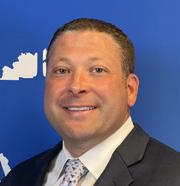



Brandon Maggard Account Representative KenBanc Insurance bmaggard@kybanks.com
Chuck Maggard President & CEO KenBanc Insurance cmaggard@kybanks.com
Lisa Mattingly Director of Sales & Service KBA Benefit Solutions lmattingly@kybanks.com
Tammy Nichols Finance Officer HOPE of the Midwest tnichols@hopeofthemidwest.com
Katie Rajchel Accounting Manager krajchel@kybanks.com
Timothy A. Schenk General Counsel tschenk@kybanks.com
Selina O. Parrish Director of Membership sparrish@kybanks.com
Jessie Southworth Director of Education jsouthworth@kybanks.com
Jennifer Schlierf Sales Support KBA Insurance Solutions jschlierf@kybanks.com



Jamie Hampton Education Coordinator jhampton@kybanks.com
Tamuna Loladze Chief Operating Officer HOPE of the Midwest tloladze@hopeofthemidwest.
Michelle Madison IT Manager mmadison@kybanks.com

Matt Simpson Communications Director msimpson@kybanks.com Visit us online at KYBanks.com



Matthew E. Vance, CPA Chief Financial Officer mvance@kybanks.com
Billie Wade Executive Director HOPE of the Midwest bwade@hopeofthemidwest.com
Audrey Whitaker Insurance Services Coordinator awhitaker@kybanks.com
CHAIRMAN
W. Lee Scheben, President, Heritage Bank, Inc., Burlington
VICE CHAIRMAN
J. Jason Hawkins, President/CEO, 1st United Bank & Trust Co., Madisonville
TREASURER
Alex Cook , President & CEO, Hearthside Bank, Middlesboro
GROUP REPRESENTATIVES
Represents Group 1
Michael Radcliffe, CEO/CCO, Community Financial Services Bank Benton
Represents Group 2
Douglas E. Lawson, President & COO, Field & Main Bank, Henderson
Represents Group 3
Logan Pichel, President & CEO, Republic Bank & Trust Company Louisville
Represents Group 4
Brandon Fogle, Market President, South Central Bank, Inc., Elizabethtown
Represents Group 5
David Hertz, President/CEO, The Farmers Bank of Milton, Milton
Represents Group 6
Robert Miles, President & CEO Peoples Bank of Lebanon Lebanon
PAST CHAIRMAN
April R. Perry, Chairman & CEO, Kentucky Farmers Bank Corporation
KBA PRESIDENT & CEO
Ballard W. Cassady, Jr., President & CEO Kentucky Bankers Association
Represents Group 7
Lucas Shepherd, CEO First National Bank of Manchester Manchester
Represents Group 8
Lonnie Foley, President & CEO
Peoples Bank of KY, Inc., Flemingsburg
Represents Group 9
James Ayers, Regional Manager First State Bank, Inez
THRIFT REPRESENTATIVE
Glenn Meyers, Executive VP, Citizens Federal Savings & Loan Assoc., Covington
BANK SIZE REPRESENTATIVES
Represents Banks w/ Assets of $1B+ Tucker Ballinger, President/CEO, Forcht Bank, Lexington
Represents Banks w/ Assets of >$1B & at least $200M
Frank B. Wilson, President & CEO Wilson & Muir Bank & Trust Company Bardstown
KBA BENEFITS TRUST COMMITTEE REPRESENTATIVE
W. Fred Brashear, II, President & CEO Hyden Citizens Bank, Hyden
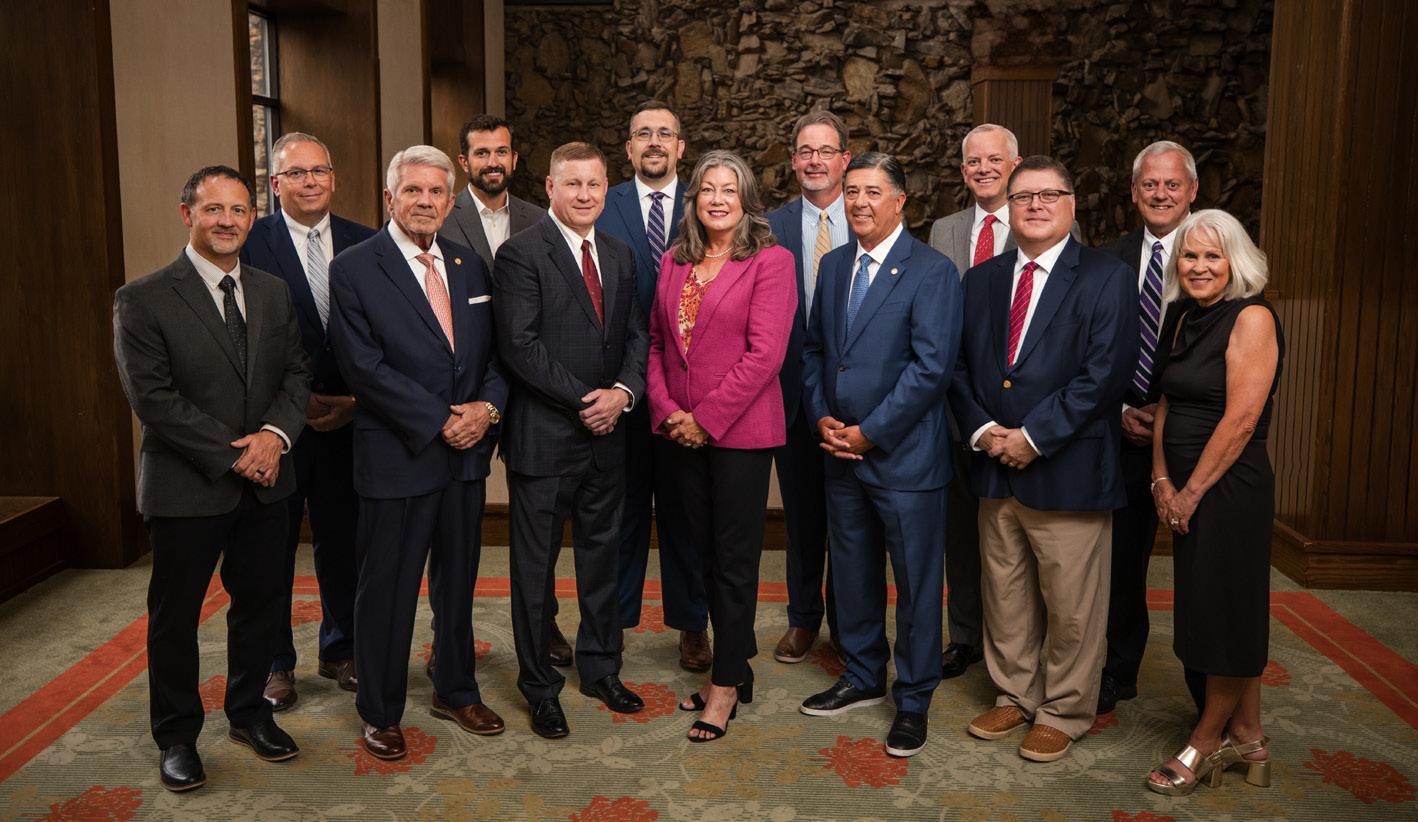
THANK YOU TO OUR ADVERTISERS AND CONTRIBUTORS
BANC CONSULTING PARTNERS
COMPLIANCE ALLIANCE DELUXE FHLB CINCINNATI
POTTINGER MCGARVEY
NCONTRACTS
OCCH






by Lee Scheben Incoming KBA Chairman of the Board President, Heritage Bank
AAs I sit here writing my first article for Kentucky Banker, I’m reminded of the outstanding people who make up the banking community across this Commonwealth. I thoroughly enjoyed meeting so many of you at our Annual Convention and look forward to connecting with many more over the next year.
Speaking of the convention—what an incredible job by our KBA team in organizing and running such an important event. The speakers were engaging and informative, and the food and fun were over the top. A special thanks to our many vendors who sponsored, exhibited, and helped make it all possible. The energy throughout the event was strong and positive.
For those who couldn’t attend, I hope to see you at one of our upcoming events. As a fourth-generation banker, I remain deeply committed to community banking and to serving our local communities across the Commonwealth. Our banks are the lifeblood of our markets, and we’ve always been there to help make our communities stronger—through lending, counseling, and volunteer service.
Looking ahead, we face significant challenges—regulatory changes, advances in AI, stablecoin, and increasing fraud. We will need everyone engaged to ensure community banks continue to thrive. We’re preparing now for our upcoming trip to Washington, so please reach out with any issues or concerns we can address. The upcoming session in Frankfort also promises to be active, particularly as we confront new credit union proposals that could impact our industry.
Finally, as I mentioned at the Convention, we need every bank’s support for KBPAC. We reached a record level of engagement last year and will need to do so again to protect our priorities. Our collective voice is powerful—let’s continue to use it.

Welcoming our new KBA Chairman of the Board, Lee Scheben!
by Ballard Cassady KBA President & CEO
TWhen someone asked me the other day why my articles always seemed so angry, I was a little taken aback. I like to think I was just scattering “seeds of truth” with the hope that some would land in fertile soil. But I went back and read a few. Sure enough, the anger that fueled some of those articles pretty well jumped off the page. By way of introspection, I’ve asked myself how much of it was justified.
The core of my job is advocacy for a vitally important industry that Congress and the federal bureaucracy seem to have singled out for shabby treatment over the past 40 years. Anyone doing this job without getting mad as hell about that either isn’t watching or is on happy pills.
My anger at blatant political malpractice has never stopped at Congress. As my ol’ granny reminded me pretty constantly, “You reap what you sow!” We can’t blame members of Congress and forget who put them there. Yes, we can blame a first-termer for following the money and listening to all the wrong voices. After that? Shame on us!
On to my latest rant, for which I make no apology: the GENIUS Act.
What is going on with this? Why do we even need it? The best answer I have gotten so far is that we need it to increase the sales of Treasuries to help with our debt. Really, that’s the best I’ve heard yet (that makes sense). I’ve heard a ton of garbage reasons... faster payment rails, better for global transactions, yada, yada, yada. We have the best banking system in the world, and Congress, for no clear reason, is trying its best to destroy it. Well, let me take that back. They have 130 million reasons—the amount of PAC dollars spent this cycle by the FinTech/Crypto lobby versus about $3 million from the banking industry.
This is verbatim what I sent to my counterparts around the country:
“We are facing one of the biggest paradigm shifts in banking in my 50-year career, which includes banking, regulatory, and trade association work. This bill threatens the very ecosystem of community banking across America.”
And so, I continue to throw my seeds of truth out there and maybe... just maybe... some will take root.
Meanwhile, our industry has no choice but to get ready for Stablecoin. The GENIUS Act is law now, and banks will have to learn to function inside the law’s provisions—or perhaps it’s truer to say, in spite of the law’s provisions. We will do our best as time moves on to give everyone our best shot at adapting to this bill. But as of right now, I’m betting there aren’t ten people who have a clue as to how this will affect our industry. A Treasury report states they expect stablecoins to be a $6.6 trillion industry by 2028, and of that amount, about $2.2 trillion will come from traditional bank deposits.
Can every community bank survive an asset transfer of that magnitude? Not likely. Raise that as a concern in political circles and the conversation often makes a quick turn to facilitation of de novo banks. My response to that is, “How about we just protect those we have and make it easier for them to serve their communities, as opposed to always coming up with ingenious ways to destroy them?” (If said with a pleasant tone, does that still come across as angry?)
In other news, we just wrapped up our 2025 convention in Asheville, N.C., and from all reports and surveys, it was probably our best. Thanks to all our speakers and vendors. There is always a world of effort that goes into the convention every year, and this one was a little more stressful than most due to the horrific damage done by storms in Asheville. They are coming back strong, and we were so glad to help be a part of that.
Next year, we will go to the Mayflower Hotel in Washington, D.C., for our convention. We are putting time on the front and back end of the convention for our members (and their families) to visit the iconic monuments, memorials, and museums that are unique to our nation’s capital. A lineup of extraordinary speakers is already taking shape for this convention in the “belly of the beast,” the place where most banking law and regulation is birthed—and occasionally buried. We look forward to seeing you there.


by Timothy Schenk KBA General Counsel
AAnother stablecoin article? Really?!
Yep! I readily acknowledge that there are looming threats to banking beyond stablecoin, but I’m of the opinion that none pose a larger existential threat to the future of our industry. Think your communities will not run to convert traditional deposits to stablecoin? Think again. What if I told you that Bridge, the stablecoin infrastructure arm of Stripe, has submitted an application to the Office of the Comptroller of the Currency to organize a national trust bank as competition? Other fintechs like Circle, Ripple, and Paxos have also applied for charters. We could see retailers apply for similar charters. While I don’t want to provide a legal interpretation of the law, what if your customer could theoretically receive a discount at Walmart for paying with a Walmart stablecoin? Now, are you concerned?
How about the matriculation of deposits? There are various reports as to estimated losses for community banks, but the lowest figure I’ve seen is $1 trillion. Yes, $1 TRILLION. The shift from traditional deposits to stablecoins poses a fundamental challenge: stablecoin holdings cannot serve as loanable funds, eroding the very mechanism that supports community lending.
Section (4)(a)(2) of the GENIUS Act states:
PROHIBITION ON REHYPOTHECATION. —Reserves required under paragraph (1)(A) may not be pledged, rehypothecated, or reused by the permitted payment stablecoin issuer, either directly or indirectly, except for the purpose of—
(A) satisfying margin obligations in connection with investments in permitted reserves under clauses (iv) and (v) of paragraph (1)(A);
(B) satisfying obligations associated with the use, receipt, or provision of standard custodial services; or
(C) creating liquidity to meet reasonable expectations of requests to redeem payment stablecoins, such that reserves in the form of Treasury bills may be sold as purchased securities for repurchase agreements with a maturity of 93 days or less, provided that either—
(i) the repurchase agreements are cleared by a clearing agency registered with the Securities and Exchange Commission; or
(ii) the permitted payment stablecoin issuer receives the prior approval of its primary Federal payment stablecoin regulator or State payment stablecoin regulator, as applicable.
In short, unlike traditional deposits, banks are prohibited from lending stablecoin deposits. That’s problematic for all of us.
Why is this happening? What we’re discovering in real time is that many of the supposed “drivers” behind stablecoin adoption don’t actually benefit from it. A policy contact in Washington put it well: “You might think the crypto groups would be thrilled. They’re not. What they really want is clarity—a defined market structure.”
So who does benefit? Treasury.
The ever problematic Section four (4) of the GENIUS Act states:
(a) STANDARDS FOR THE ISSUANCE OF PAYMENT STABLECOINS.— (1) IN GENERAL.—A permitted payment stablecoin issuer shall—
(A) maintain identifiable reserves backing the outstanding payment stablecoins of the permitted payment stablecoin issuer on an at least 1 to 1 basis, with reserves comprising—
(i) United States coins and currency (including Federal Reserve notes) or money standing to the credit of an account with a Federal Reserve Bank;
(ii) funds held as demand deposits (or other deposits that may be withdrawn upon request at any time) or insured shares at an insured depository institution (including any foreign branches or agents, including correspondent banks, of an insured depository institution), subject to limitations established by the Corporation and the National Credit Union Administration, as applicable, to address safety and soundness risks of such insured depository institution;
(iii) Treasury bills, notes, or bonds— (I) with a remaining maturity of 93 days or less; or (II) issued with a maturity of 93 days or less; (iv) money received under repurchase agreements, with the permitted payment stablecoin issuer acting as a seller of securities and with an overnight maturity, that are backed by Treasury bills with a maturity of 93 days or less;
In short, the reserves can sit in accounts without yield or go into Treasury bills with a yield. I wonder where that money will go. The Federal Reserve Bank of St. Louis released a bulletin on stablecoin.
The bulletin states, “Congress recently passed legislation (the GENIUS Act) that establishes a framework for the issuance of U.S. dollar stablecoins, a cryptoasset intended to maintain a stable value relative to some other asset. This framework could boost demand from stablecoin issuers for U.S. Treasuries, the deepest, most liquid market in the world.”
“Although the stablecoin market is currently too small to have a large effect on Treasury demand, the market is expected to grow substantially over the next several years...J.P.Morgan recently projected the stablecoin market to reach $500 billion by 2028, while Standard Chartered estimated $2 trillion by 2028 and Bernstein $4 trillion by 2035 (Singh 2025).”
“If the stablecoin market meets these growth projections, it could lead to a substantial redistribution of funds within the financial system. Funds flowing into stablecoins have to flow out of another source. If stablecoins are purchased out of checking accounts, for example, then these purchases represent a shift of funds from banks (as deposits) to issuers (as stablecoins). Although some issuers may themselves be banks, stablecoins differ from deposits in important ways.”
“Bank deposits may be backed by other assets, most notably loans directly to the economy, and are ultimately backed by the full faith and credit of the United States for insured deposits. Loosely, under the GENIUS Act, issuers must completely back their stablecoins with Treasuries, physical cash, demand deposits at depository institutions, certain repurchase agreements, certain money market funds, or as reserves at the Federal Reserve. Because deposits and stablecoins are both used transactionally, many stablecoins will likely be purchased using money currently held in banks as deposits.”
“This potential flow of funds from bank deposits into stablecoins could increase Treasury demand but also could reduce
the supply of loans in the economy. Today, U.S. banks hold around $26 trillion in total assets, 20 percent of which are Treasuries (about $5 trillion total). However, Treasuries make up an even higher share of assets held by stablecoin issuers (about half). If banks and issuers’ asset mixes continue to hold, a shift of funds from banks to stablecoin issuers would necessarily increase Treasury demand, as the increase in issuer Treasury holdings would more than outweigh the decrease in bank holdings. However, banks also hold about 50 cents of every dollar in loans directly to the economy (or about $13 trillion). Legislative requirements preclude stablecoin issuers from using their funds to make traditional loans directly to the economy. Thus, while shifting funds from banks to issuers could potentially increase demand for Treasury debt (particularly shorter-term debt), it would also mechanically reduce the potential supply of loans to the economy.”
While fintechs are certainly positioning themselves to benefit from stablecoin, the true beneficiary is the Treasury. A mass purchase of U.S. treasuries only solidifies the dollar’s dominance as the world’s currency and deeply ties consumers to the government.
Some might call it conspiratorial, but it’s hard to ignore that Treasury stands to gain more from stablecoin than anyone else. Once again, those gains appear to come at the expense of banks. I’d like to be wrong— but without legislative action that reaffirms the central role of banks in our economy, the odds are stacked against us.


We live in a time where we are more connected than ever. Throughout the day we are bombarded with notifications of the latest breaking news and a social media feed that’s always a click or swipe away. This constant overload makes it difficult to focus for extended periods of time and do the cognitively demanding work that really matters. That is the theme of author Cal Newport’s 2016 book, Deep Work: Rules for Focused Success in a Distracted World. Newport argues that learning how to focus deeply is not just valuable but is in fact vital for one to succeed in today’s environment. Even though this work is almost a decade old, I believe that the ensuing years have only solidified what Newport argues for.
Newport writes about two main types of work- shallow and deep. He defines shallow work as tasks that are done throughout the day that are not cognitively demandingchecking social media and replying to email for example. Deep work, on the other hand, is defined as an activity that is “performed in a state of distraction-free concentration that push your cognitive capabilities to their limit. These efforts create new value, improve your skills, and are hard to replicate”. Shallow work, while always feeling urgent, rarely moves us or our organizations forward. Conversely, deep work can lead to breakthroughs, sustainable skill development and real productivity. Concerning skill development, Newport believes that the ability to quickly learn hard things and produce at an elite level are the keys to success. Both require deep work. Newport likens the ability to concentrate without distraction to a superpower and yet, it’s a superpower that is being eroded by our


digital habits. Those who can reclaim this ability will have an enormous competitive advantage over those that cannot.
How to implement deep work? Newport offers four rules to follow:
Rule #1: Work Deeply
As much as we might wish it were so, deep work doesn’t just happen. This requires us to build routines and rituals that support it. Newport offers ideas ranging from scheduling deep work sessions into your calendar to some extremely monastic solutions such as disappearing to a cabin. Reading about Bill Gates ‘think weeks’ puts much of this into perspective. Whether it’s a few hours of undistracted time scheduled weekly or a week of isolation, the key is intention. Absent intention the urgent will get in the way of the important.
Rule #2: Embrace Boredom
Newport argues that we have an addiction to distraction and that social media and digital devices are our enablers. To cultivate the deep focus that is required to do the most important work, we must retrain our brains to tolerate boredom. To build mental discipline, Newport suggests scheduling social media time and general internet surfing, thus reducing our impulsive behaviors.
Rule #3: Quit Social Media
This is a difficult one to grasp and I would be interested in an updated view of this from Newport. He argues here that most people should use social media far less, if
at all. He urges a minimalist approach to technology and a shift to intentional, value driven use of it.
Rule #4: Drain the Shallows
Newport acknowledges that some shallow work is unavoidable but urges that it should be minimized and contained. To do this, the suggestion is to audit your schedule to identify how much time you spend on shallow work with the goal of reducing it substantially. Two recommendations that stick out here are time blocking to plan your day in advance and being more selective with commitments by simply saying no when it is going to interfere with deep work.

Helping Kentucky’s Community Banks Plan for What’s Next

BCP works exclusively with community banks to develop non-qualified benefit strategies and Bank-Owned Life Insurance (BOLI) solutions that align with long-term goals.
To learn more about how BOLI can enhance core financials—and how non-qualified benefit plans can help attract and retain the leaders who drive long-term success—contact Lou or Lon at Banc Consulting Partners.




by Jessie Southworth KBA Director of Education
IIn response to the fentanyl crisis, Congress passed the FEND Off Fentanyl Act, which added Section 2313(a) to Title 21 of the U.S. Code. This new provision authorizes the Secretary of the Treasury to impose up to six special measures on institutions identified as posing a primary money laundering concern tied to illicit opioid trafficking.
To qualify as a 2313(a) designated entity, an institution must:
* Be involved in, or connected to, money laundering activity related to illicit opioid trafficking; and
* Operate as a financial institution, a class of transactions, or an account in or connected to a jurisdiction outside the United States.
1. Establish recordkeeping requirements for certain financial transactions.
2. Retain information on beneficial ownership.
3. Retain information on payable-through accounts.
4. Retain information on correspondent accounts.
5. Impose conditions—or outright prohibitions—on maintaining correspondent or payable-through accounts.
6. Restrict or condition the transmittal of funds involving designated entities.
On June 25, 2025, FinCEN issued orders against three Mexicobased financial institutions:
* CIBanco S.A., Institución de Banca Múltiple
* Vector Casa de Bolsa, S.A. de C.V.
* Institution de Banca Múltiple
Each was identified as exhibiting primary money laundering
concerns connected to illicit opioid trafficking. Beginning October 20, 2025, covered U.S. financial institutions must cease all fund transfers to and from these entities.
Key points to note:
* There is no requirement to review past transactions before the effective date.
* The order does not create new suspicious activity monitoring obligations—institutions should continue following existing procedures.
2313(a)-designated entities differ from OFAC-sanctioned entities in several important ways:
* Institutions are not required to block or freeze transactions.
* Transactions involving these entities do not have to be reported to OFAC.
* Because these entities are not on the OFAC list, they won’t appear in OFAC screening results—institutions must account for them separately.
* Engage with your core provider or AML software vendor to confirm your system can identify and flag 2313(a) entities.
* Implement internal procedures that ensure compliance with the order, including controls tied to the six special measures.
* Exercise due diligence when processing transactions that could involve these institutions.
* Consult with auditors conducting your Bank Secrecy Act reviews to confirm that 2313(a) requirements are included in their scope.
Is your institution making a reasonable effort to comply with this order—and have you established procedures to prevent these transactions from being processed?
Deluxe is here to help build and grow your brand in ways that strengthen customer relationships and your financial institution’s true potential. Improve your customer experience, elevate operations and maximize profit potential. Contact Deluxe today to find out how.
Checks
Personal & Business Checks
Cash Management & Supply eChecks Official Checks & Forms
Data-Driven Marketing
Data-Driven Marketing Digital Referral & Acquisition Banker’s Dashboard MyCorporation
Promotional
Promo & Apparel

Giveaways, Gifts & Recognition
Commercial Printing Print & Mail
Payments
Deluxe Receivables+ Suite Lockbox+, eLockbox+ & RDC
Deluxe Payment Exchange+
Deluxe Merchant Services

Get your bank to be at its branding best.
Contact Dean DiMidio, Regional Client Manager at dean.dimidio@deluxe.com, or 814.883.0355


FFair lending compliance isn’t just about checking boxes — it’s about demonstrating a genuine commitment to equitable access to credit. For lenders, effectively communicating this commitment to boards, regulators, and examiners is crucial.
With regulators facing staffing shortages and conducting more focused exams, telling your fair lending story helps provide critical context. Proactively sharing your efforts, controls, and improvements ensures your institution’s narrative is clear.
Here are some best practices to help you craft and present your fair lending narrative with confidence and clarity.
A clear, well-defined framework is the foundation of your fair lending story. It outlines governance, roles, and ownership, showing regulators and stakeholders that your institution has dedicated resources and a proactive approach.
Regulators expect to see established controls, including policies, training, monitoring, and audits, as part of a solid fair lending compliance management system (CMS). Leading with this structure
aligns with examiner expectations and demonstrates that fair lending is thoughtfully embedded into your operations.
You can’t effectively focus your compliance efforts without identifying where your fair lending risks lie, and that starts with analyzing your data. Are you reviewing the Home Mortgage Disclosure Act (HMDA) and non-HMDA data for potential disparities? Regular analysis is critical for spotting elevated fair lending risk. When potential disparities are identified, document and analyze them using tools such as comparative file reviews to uncover and explain the root causes.
When telling your fair lending story, consider highlighting these key areas:
• Fair Lending Risk Assessments: Share findings from periodic assessments that consider the effectiveness of current controls or outcomes from testing completed when regulatory actions (published consent orders or regulatory publications) identify possible fair lending risks that were not previously tested by your institution.
• Application and Outcome Analysis: Present comparative data on applications, approvals, pricing, and terms across protected classes to show fair and consistent treatment.
• Corrective Actions: Explain any anomalies detected, how they were investigated, and the actions taken to address them.
Framing your data this way supports your narrative and demonstrates a disciplined, data-driven approach to fair lending compliance.
Examiners expect lenders to take a modern, technology-driven approach to managing fair lending risk. While each institution’s tools and resources will vary based on size and product offerings, demonstrating how you leverage technology and internal controls is key to telling a strong fair lending story. Focus on the systems and safeguards you’ve established to identify, monitor, and mitigate risk across the loan lifecycle.
Key areas to highlight include:
• Automated Tools: Describe how your
fair lending software helps proactively test loan data for potential disparities and discriminatory patterns.
• Third-Party Oversight: If you rely on third parties for underwriting, origination, or data processing, explain your oversight practices and how you ensure vendors align with your fair lending standards.
• Audit and Testing: Detail the scope of your internal and external audits, including how you test for compliance, interpret results, and apply findings to strengthen your program.
By clearly explaining your use of technology and controls, you can reinforce your institution’s commitment to fair lending through transparency, accountability, and continuous improvement.
Highlight Proactive Engagement and Transparency
Regulators value transparency and proactive communication, so it’s crucial to show how your institution keeps stakeholders informed and engaged throughout the fair lending process.
Describe how fair lending metrics and risk indicators are regularly reported to the board and senior leadership, ensuring visibility and oversight at the highest levels.
Additionally, highlight any collaborations with community organizations or regulatory agencies to address lending disparities and support fair housing initiatives, reinforcing your institution’s broader commitment to equity.
Finally, explain how your team responds to internal testing or examination findings, including timely remediation, updates to policies or procedures, and ongoing improvement efforts. These actions demonstrate that your fair lending program is both responsive and forward-looking.
Adapt your fair lending story to the specific needs of each audience. When presenting to the board, focus on strategic implications, such as reputational risk, compliance posture, and governance oversight. Use precise language and visual summaries to make potential risks easily identifiable and provide enough information to support informed decision-making.
For regulators and examiners, provide more detailed documentation, including detailed data analysis, monitoring results, and corrective actions. Be transparent about any challenges and emphasize your institution’s actions that demonstrate your commitment to ensuring fair credit practices.

A candid, audience-specific approach strengthens credibility and ensures each audience is receiving the information that is most important to their roles and responsibilities.
Effectively telling your fair lending story is about easily identifying risks for corrective action and showcasing the efforts made by your institution to ensure equitable credit access. By planning your communications by audience and using the right level of data transparency and narrative clarity, you can build trust, highlight accountability, and reinforce your institution’s dedication to fairness in lending.










By Stephanie Shenoda Compliance Alliance compliancealliance.com
RRegulation CC, issued by the Federal Reserve Board, governs the availability of funds and the collection of checks in the United States. It ensures transparency for depositors regarding when they can access funds from check deposits and outlines rules for financial institutions on how to handle these deposits. One critical component of Regulation CC involves threshold amounts, which are periodically adjusted for inflation. The most recent update, effective July 1, 2025, brings changes that banks and credit unions must implement — not only operationally, but also in how they notify customers. This article breaks down the updated threshold amounts, explains their practical implications, and highlights what financial institutions must do to remain compliant, particularly regarding customer communications.
Regulation CC (12 CFR Part 229), also known as the Availability of Funds and Collection of Checks regulation, is rooted in the Expedited Funds Availability Act (EFAA). It specifies:
• How long a bank can hold deposited funds before making them available to the customer.
• What disclosures must be made regarding funds availability.
• Procedures for processing returned checks.
• Maximum timeframes for extended holds based on risk, check type, and deposit method.
The regulation also includes specific dollar amounts (thresholds) that trigger different availability timelines, such as the “next-day availability” amount and the “large deposit exception” amount. These thresholds are adjusted every five years for inflation.
The Federal Reserve and the Consumer Financial Protection Bureau (CFPB) announced updated thresholds that will take effect on July 1, 2025. These changes are designed to maintain the real-dollar value of certain regulatory provisions over time. The minimum amount of a deposited check that must be made available by the next business day will increase to $275, up from the previous $225. The cash withdrawal amount subject to extended holds will rise to $550. For new accounts, the threshold for funds made available by the next day will increase to $6,725, as will the threshold for identifying large deposits and repeated overdrafts, which are also used in
determining eligibility for extended holds.
Additionally, the civil liability amounts under Regulation CC will be adjusted: the minimum liability for individual actions will increase to $125, while the maximum will rise to $1,350. For class actions, the maximum allowable liability will increase to the lesser of $672,950 or 1% of the bank’s net worth. These changes reflect a 21.8% rise in the Consumer Price Index (CPI-W) from July 2018 to July 2023, and institutions are required to update disclosures and notify consumers accordingly.
Banks and credit unions must ensure their funds availability policies, core systems, and deposit platforms reflect the updated thresholds. For instance, when a customer deposits a check and qualifies for next-day availability, the first $275 (up from $225) must be made available the next business day. The remainder can be subject to standard holds.
Systems that automate hold amounts or generate customer disclosures must be reprogrammed to align with the new figures.
Under Section 229.16(c)(3), when a financial institution changes its policy in a way that expands the availability of
funds, it must notify customers no later than 30 days after implementing the change. Since these threshold increases generally benefit customers by shortening hold times or increasing early availability amounts, they are considered “positive” changes. However, failing to notify customers within this window could result in noncompliance and potentially subject the institution to penalties or examiner scrutiny.
Here is how institutions can meet the Regulation CC customer notification requirements effectively:
• Notifications must be sent no later than August 1, 2025 (30 days after the effective date).
• Institutions may choose to send the notice before July 1, 2025, as a proactive measure, but are not required to do so.
Financial institutions can use any of the following methods:
• Mailing a printed notice to the last known address.
• Delivering electronically, if the customer has consented to electronic disclosures under the E-SIGN Act.
• Posting a notice in-branch and on the institution’s website (for walk-in customers and general awareness, but another method must also be used).
• Including a message on monthly statements or digital banking notifications.
Customers may not notice the change immediately, but the update means:
• Faster access to funds from eligible check deposits.
• Increased dollar amounts before longer holds apply.
• Improved transparency through timely notifications from their banks.
Educating frontline staff is essential, as customers may have questions once they begin noticing slightly different availability patterns on their accounts.
The Regulation CC threshold, update effective July 1, 2025, marks another step in keeping federal banking regulations in step with inflation and modern banking realities. Financial institutions must adjust their internal systems, update disclosures, and communicate the changes clearly to customers. While the changes are generally customerfriendly, strict compliance with timing and format of notifications is vital to avoid regulatory pitfalls. By staying informed and proactive, institutions can ensure a smooth transition and maintain customer trust in the evolving regulatory landscape.

Stephanie Shenoda, MBA, serves as a Compliance Officer on the Compliance Hub Reviews & Products team. She graduated from Stony Brook University with a Bachelor of Science in Business Management and afterward earned a Master of Business Administration at Molloy University.


By Dr. Sean Payant Haberfeld haberfeld.com
MMany financial institution executives spend considerable time thinking about strategies to improve efficiency in order to improve overall profitability. The efficiency ratio is the ratio of non-interest expenses (less amortization of intangible assets) to net interest income and non-interest income, so it is effectively a measure of what you spend compared to what you make. The very name – “efficiency ratio” – makes us think about how efficient we are with those precious income dollars. If a financial institution has a high efficiency ratio, they are simply spending too much of what they make…right? That is exactly what the name implies (emphasis on the spending side of the equation). But this is just a ratio of two numbers, and as we all know, there are two ways to bring the ratio down – reduce costs or increase revenues.
The focus across industry press and conference best practices is generally aimed at strategies to cut expenses – using technology, looking at staffing levels, increasing productivity, etc. Although this advice is sound, what happens when a financial institution has already cut what can be cut AND it is still struggling with efficiency? It is sometimes difficult to save your way to prosperity.
For many financial institutions, the focus should also be on the bottom portion of the equation – increasing revenues. Let’s look at an institution that has $500 million in assets, a good return at 1% ROA, and a reasonable efficiency ratio of 60%. Let’s assume the FI can improve its efficiency ratio by 5% through revenue increase or expense reduction.
It shouldn’t be surprising that increasing revenues provides better performance even though this sometimes seems like a counterintuitive approach. Because many financial institutions need to increase investments for growth in order to significantly grow their revenues, thereby increasing the expense side of the equation, and because of their excess capacity, this will actually make them more efficient over time. Many financial institutions have cut expenses almost to the bone and can’t materially improve their efficiency ratio by further reducing costs. They need to take a step back and realize some fundamental business dynamics that are often ignored in our industry.
Most community financial institutions still have tremendous excess capacity, meaning they could serve significantly more customers without significantly increasing
expenses. The answer to improving the efficiency ratio is to fill excess capacity with brand NEW profitable customers.
How do other businesses look at the issue of excess capacity – for example a manufacturing company?
•The facility is running at 50% of the capacity it was built to produce;
• The factory has done everything it can to be as efficient as possible – evaluate staffing levels, implement technology solutions, etc.
• Management’s major goals and objectives are still focused on improving profitability by further evaluating already efficient processes and selling more to current customers.
Given the excess capacity at the manufacturing company, wouldn’t it also make sense to evaluate if more widgets can be run through the facility? Would the market support providing more products to more people in order to increase net income without substantially increasing expenses?
The manufacturing company analogy is very similar to the situation being faced by community financial institutions.

Ransomware locks your systems. Customer data is exposed. Phones are ringing. No one knows what to do.
You thought it wouldn’t happen to you. But now you’re hemorrhaging trust, time, and money.





As federal enforcement has slowed, states aren’t just filling the void — they’re redefining it.
Attorney General Andrea Joy Campbell of Massachusetts recently made that clear with a $2.5 million settlement against Earnest, a student and personal loan provider, for fair lending violations tied to artificial intelligence-driven underwriting and flawed consumer disclosures.
Massachusetts isn’t the only state getting involved. State-level fair lending enforcement is beginning to heat up and the message is clear: regulators at the state level are getting equipped and empowered to root out discrimination in lending. For lenders, especially those relying on AI models, this wave serves as a wake-up call to stay proactive, actively mitigate emerging risks, and continuously adhere to best practices to remain compliant.
From 2014 to 2020, Earnest allegedly failed to maintain adequate fair lending controls, leading to discriminatory outcomes across both AI-driven and manual underwriting. The violations included untested algorithms that produced disparate
impacts, undocumented manual overrides, problematic “knockout” rules that automatically eliminate individuals from loan considerations based on specified inputs, and misleading adverse action notices. While the activities in question stopped years ago, Massachusetts is holding lenders accountable through a governance overhaul and ongoing compliance reporting, sending a clear message that outdated and potentially discriminatory practices—whether they involve AI or not— are still subject to enforcement.
What makes this case stand out isn’t just the scope of the violations — it’s that they were preventable. Leveraging AI and automation can undoubtedly streamline workflows, but regulators expect more than efficiency. They expect transparency, fairness, and control. If your institution can’t explain how a model makes decisions, can’t prove it’s been tested for bias, or can’t govern when and how exceptions are made, you’re creating a perfect storm for compliance risk.
While the Massachusetts enforcement action is notable, it’s not the only fair lending action we’ve seen from state regulators recently.
New Jersey took action against a cash advance company after executives were reportedly caught on tape directing employees to avoid working with certain racial and ethnic groups — a stark example of overt discrimination. At the same time, the state’s Attorney General is actively investigating redlining by traditional lenders, using demographic lending patterns to identify and address potential disparities.
New York is actively investigating small business and consumer lenders for biased underwriting, deceptive disclosures, and predatory practices — actions that have already led to sizable settlements and public consent orders. Adding to the pressure, the state’s FAIR Business Practices Act imposes new, lender-specific consumer protection requirements that raise the compliance bar even higher.
States, including California, Oregon, and Texas, are zeroing in on AI-driven underwriting models under consumer protection and anti-discrimination laws.
The common thread among state regulators is the growing concern that algorithmic decision-making, often presented as objective and efficient, can quietly replicate or even exacerbate existing biases, especially when human overrides occur without proper oversight.
State-level enforcement adds complexity to compliance efforts. While federal agencies tend to offer detailed guidance and consistent expectations, state actions can differ widely. For example, one state might focus on AI governance, while another targets data disclosures or pricing practices.
For risk, compliance, and legal teams, this means:
• Model governance isn’t optional. Every algorithm used in decision-making must be explainable, testable, and monitored for disparate impact. If you can’t show that your

model is fair, regulators may assume it isn’t.
• Discretion must be governed. Human overrides of automated decisions need written policies, documented justifications, and regular review. Discretion without discipline is a growing liability.
• Adverse action notices are high-stakes. These aren’t routine disclosures — they’re a compliance catalyst. Vague or inaccurate notices can erode consumer rights and invite regulatory scrutiny.
• Historical blind spots carry current risk. Today’s fair lending standards are being applied to lenders’ past practices. Institutions must be willing to audit their past and rectify any issues that are identified.
For lenders operating across state lines, the challenge is even greater. The patchwork of expectations means fair lending risk management must be scalable, nuanced, and responsive to multiple regulatory regimes simultaneously.
The days of treating fair lending as a box-checking exercise are over. Enforcement is becoming increasingly sophisticated, targeted, and localized. State attorneys general are asking harder questions about how decisions are made, how data is used, and who gets left out. And they’re not waiting for future violations — they’re reviewing the past with new scrutiny and broader tools.
These heightened expectations are a pivotal moment. Lenders can continue to view fair lending as a compliance obligation — or they can treat it as a strategic priority. Those who choose the latter will build systems that are resilient, transparent, and aligned with a more expansive definition of fairness. Those who choose the former may find themselves explaining not just today’s decisions, but yesterday’s.
The shift is already underway. The question is whether your institution is adapting or falling behind.



By H.D. Barkett IntraFi intrafi.com
WWith the Fed holding rates steady since last year, bankers are rethinking their strategies for funding and liquidity management. Today’s rate environment may tighten the spread between earning assets and liabilities, requiring bankers to adjust.
Here are three strategies bankers can leverage now to walk this tightrope.
Examine and Reprice Short-Term Liabilities
Rates that remain higher for longer will impact profitability. To counterbalance, banks will need to reprice a portion of their liabilities, reducing interest paid to some depositors. While some customer runoff will be inevitable, bankers should prudently consider their approach, as cutting rates too swiftly (or for too many customers) could lead to unexpectedly large losses in funding.
Thoughtfully considering which classes of customer will see deeper rate cuts (preserving higher rates for higher-value depositors), in conjunction with using short-term funding solutions, can help banks maintain desired funding and optimal liquidity levels. As an example, IntraFi’s ICS® service can provide floatingrate, short-term funding that reprices quickly, enabling banks to take full
advantage of potential rate-cuts and replace high-cost deposits that may leave because of rate changes. This can be done using ICS’ One-Way Buy ® feature, through which banks can access floating-rate funding at select terms (from overnight to multiyear) without collateralization requirements.
Banks will also need to check their longerterm liabilities and decide if they are worth holding or paying off early and replacing them with shorter-term, lower-cost deposits. Fortunately, the math behind this decision is easy — bankers will just need to compare the prepayment penalty against the cost of continuing to pay above-market rates.
For banks that make the decision to replace their longer-term liabilities with shorterterm funding, ICS One-Way Buy is a simple way to acquire floating-rate funding tied to an index of the bank’s choice. Institutions that are looking to reduce the burden of longer-term liabilities but still desire fixed-rate funding may benefit from leveraging CDARS® One-Way Buy, which allows banks to acquire large blocks of fixed-rate, wholesale funding and mitigate margin compression — while paying a single, all-in rate with no transaction
fees apart from the cost of funds.
The changing shape of the yield curve over the past two years has forced some institutions to take considerable losses, and, in 2023, even contributed to several notable bank failures. Most institutions have fortunately weathered the storm, though they may be holding on to unrealized losses. This latter group may be in luck — as rates decline, those once-underwater securities now have a chance to come up for air. Banks should monitor the yields of formerly upside-down bonds against the cost of funding.
These potentially recovered securities can be helpful to counterbalance any losses incurred in paying off long-term liabilities, offsetting at least some of the prepayment penalty.
These are far from the only considerations facing banks during a fundamental shift in rates, but by prioritizing these items, banks can act quickly to boost profitability during this period of change, setting themselves up for even greater success once rates settle. Solutions, such as IntraFi’s ICS or CDARS services, can provide both short- and
long-term wholesale funding alternatives, as well as depositgathering and liquidity management tools that banks can use in any rate environment.
IntraFi is not an FDIC-insured bank, and deposit insurance covers the failure of an insured bank. A list identifying IntraFi network banks appears at https://www.intrafi. com/network-banks. Certain conditions must be satisfied for “pass-through” FDIC deposit insurance coverage to apply. To meet the conditions for pass-through FDIC deposit insurance, deposit accounts at FDIC-insured banks in IntraFi’s network that hold deposits placed using an IntraFi service are titled, and deposit account records are maintained, in accordance with FDIC regulations for passthrough coverage.
Deposit placement through an IntraFi service is subject to the terms, conditions, and disclosures in applicable agreements. Deposits that are placed through an IntraFi service at FDIC-insured banks in IntraFi’s network are eligible for FDIC deposit insurance coverage at the network banks. The depositor may exclude banks from eligibility to receive its funds. Although deposits are placed in increments that do not exceed the FDIC standard maximum deposit insurance amount (“SMDIA”) at any one bank, a depositor’s balances at the institution that places deposits may exceed the SMDIA before settlement for deposits or after settlement for withdrawals or be uninsured (if the placing institution is not an insured bank). The depositor must make any necessary arrangements to protect such balances consistent with applicable law and must determine whether placement through an IntraFi service satisfies any restrictions on its deposits. ICS, CDARS, and One-Way Buy are registered service marks of IntraFi LLC.
Author Bio
H.D. Barkett is Senior Managing Director, Treasury Desk at IntraFi. Mr. Barkett has been involved in banking and financial services for more than 30 years, working with financial institutions on issues involving asset/liability management, liquidity management, risk assessment and management, and portfolio hedging. Formerly, he served five years as Vice President of Sales and Marketing and Director of New Initiatives with the Federal Home Loan Bank of Des Moines. Prior to that, Mr. Barkett was Vice President of Institutional Fixed Income sales with both Shay Financial Services and Paine Webber. For 12 years, Mr. Barkett held various management positions at Federal Home Loan Bank of Dallas in its Investments Group, Financial Strategies Group, and Sales and Marketing Department. Mr. Barkett joined IntraFi in 2002.


A look back at our time in the mountains...

The 134th Annual Convention of the Kentucky Bankers Association brought bankers together in Asheville, North Carolina, for four days of unique networking, education, and plenty of fun. Under this year’s theme, “Rising Stronger,” Kentucky bankers celebrated resilience—not only within the industry, but within the communities they serve. And that’s something the fine folks of Asheville know a thing or two about.

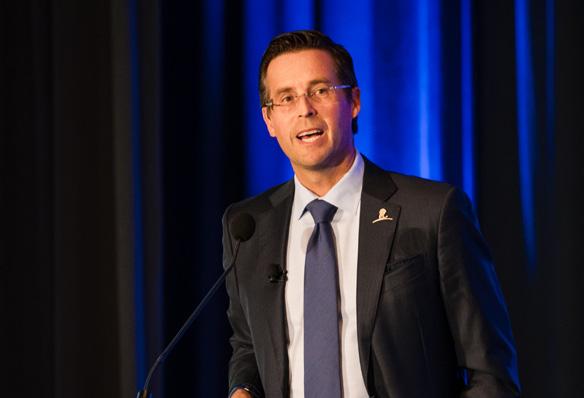


Throughout the event, attendees heard from an impressive lineup of speakers—from Commander Mark Nutsch, whose story of military bravery inspired a Hollywood blockbuster, to Vice Chair of Supervision Michelle Bowman and Congressman Andy Barr, who offered insights you can only get at an event like ours. Sessions explored everything from economic outlooks and leadership to community impact and the future of financial technology.





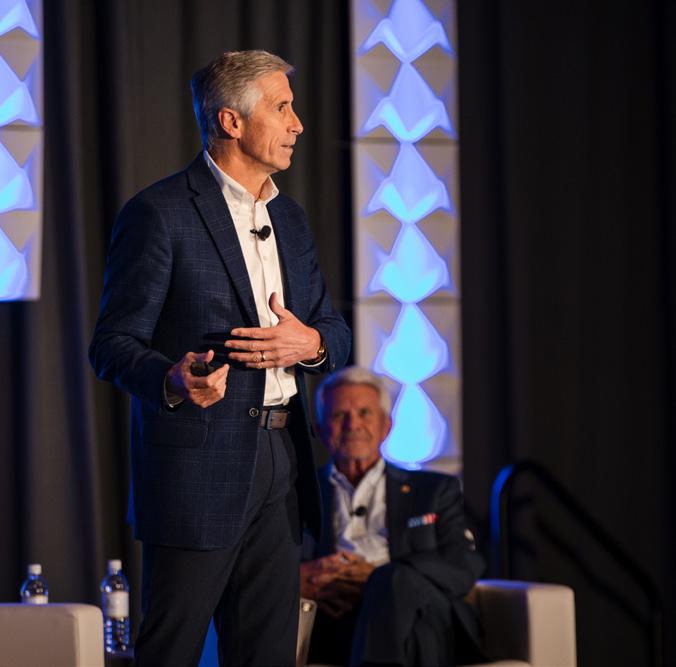

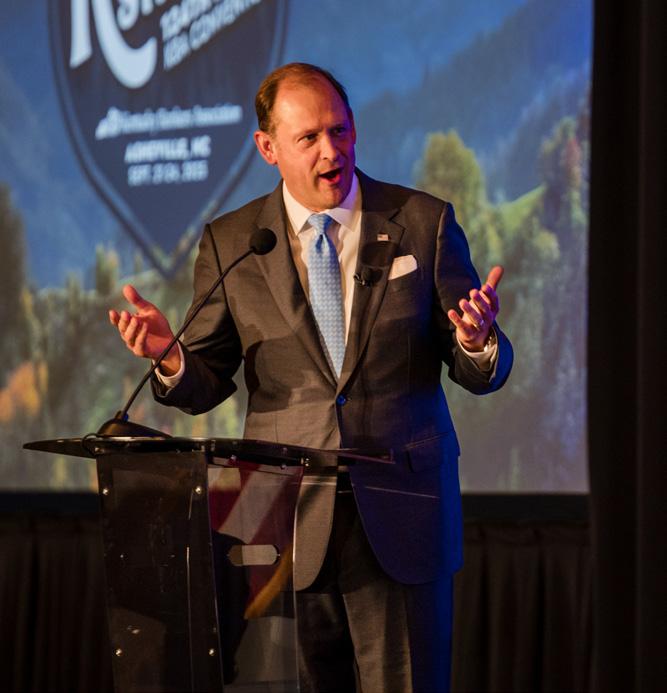


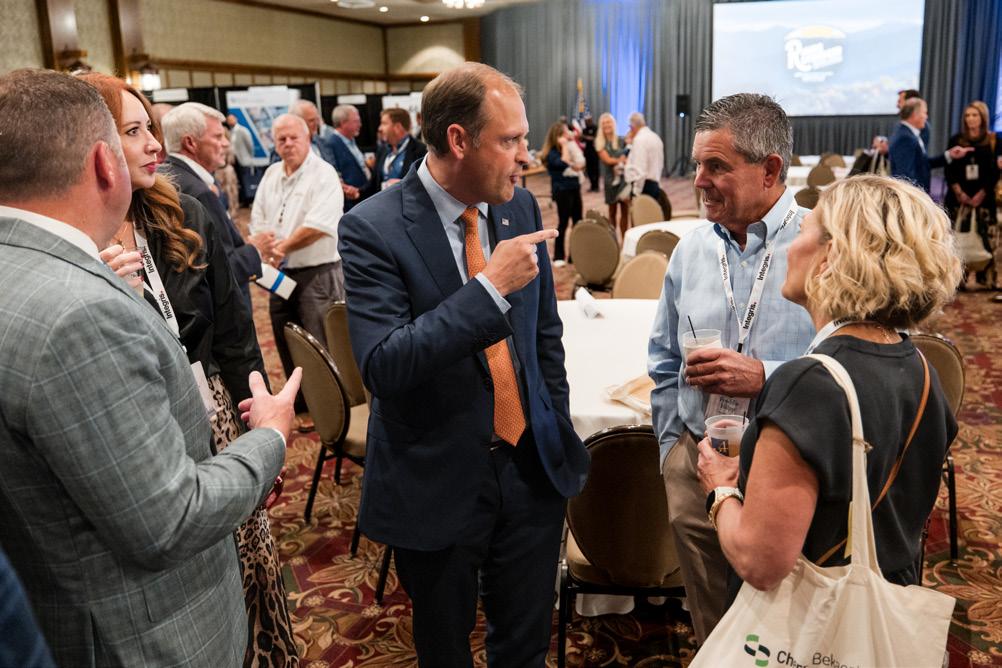
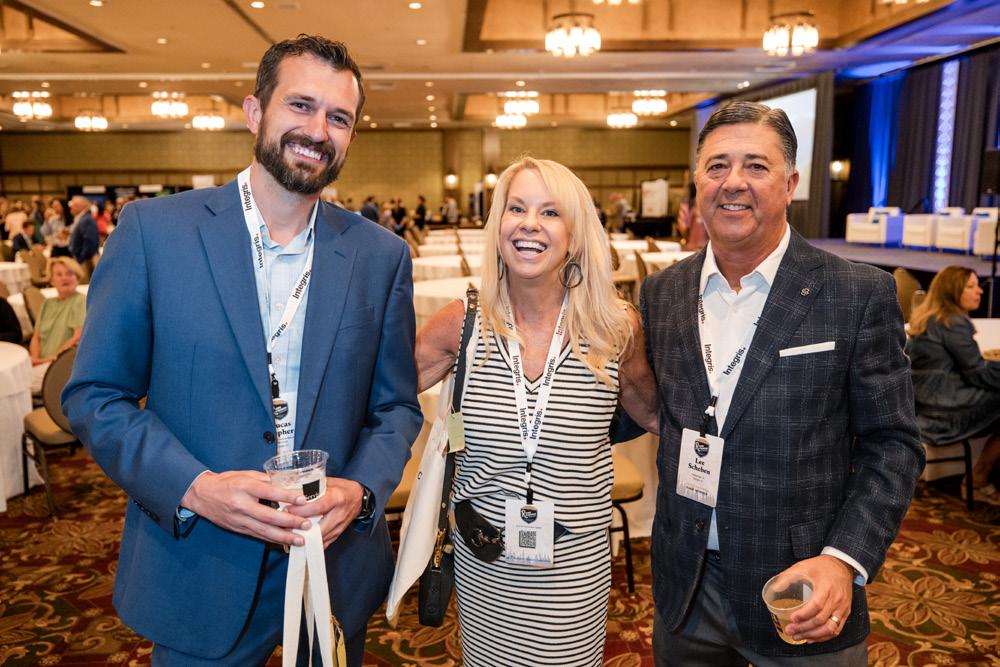

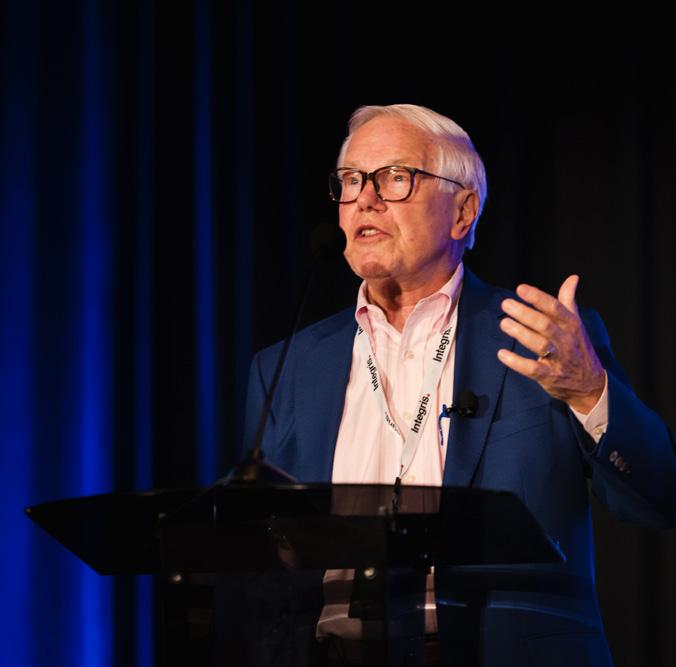


Beyond the sessions, the convention offered plenty of time to connect with colleagues and engage with exhibitors who specialize in banking. There were bourbon raffles, booth games, countless photo opportunities, and an unforgettable round of golf at the resort. A few of us even spotted a bear family on the course (though not nearly enough birdies).



As KBA continues to champion the mission of “Bankers First,” through initiatives like the Kentucky Bankers Relief Fund, this year’s convention reminded everyone why Kentucky bankers remain a powerful, united force for good. We look forward to seeing you again in 2026, when we host our firstever convention in Washington, D.C.
Announcing the 135th Annual KBA Convention!
HOSTED AT THE MAYFLOWER HOTEL
WASHINGTON, D.C.
SEPTEMBER 19 - 21, 2026 YOU SPOKE, WE LISTENED!
Mark your calendars for the 2026 Annual KBA Convention! You wanted a more streamlined schedule for maximum impact in less time. We’re making sure every session is laser-focused, every speaker essential, and every hour packed with value…all in the heart of our nation’s capital.






Save the date! The new era of KBA events begins now.

Mark Wheeler, Central Bank Louisville Market President, announced that Aaron K. Matthews has joined Central Bank as Vice President, Commercial Lending Officer. In his role, he will develop and manage commercial banking relationships to drive new business and increase revenue while ensuring community engagement.
Peoples Exchange Bank officially marked the grand opening of its Florence branch on Wednesday, August 6, 2025. This momentous occasion reflects the Bank’s ongoing commitment to expanding its services and presence across the region.
City National Bank proudly announces the promotion of Kerry Hannabach to Vice-President of Retail Branch Banking. In this new role, Kerry will continue to oversee the Versailles Region branches, expand customer relationships, grow market share, and strengthen community engagement.
Cumberland Valley National Bank & Trust (CVNB) is pleased to announce the appointment of Jason Stuecker as Senior Vice President, Louisville Market President, effective Tuesday, August 5, 2025. In this role, Jason will oversee the growth of the Bank’s commercial banking and community development efforts in the Louisville market. CVNB also would like to announce the appointment of Tom Jones to its Board of Directors, effective Tuesday, July 22, 2025. Tom’s family carries a strong legacy in the bank’s history, as his grandfather, Charles Adams Casteel, served
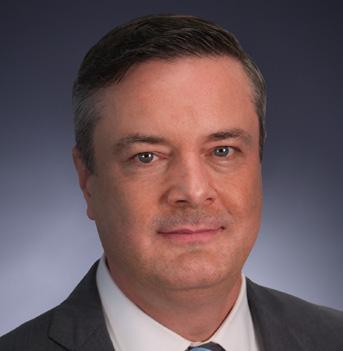

as president of the First National Bank of East Bernstadt in 1919, which would later evolve into Cumberland Valley National Bank & Trust. He joins current board members including Elmo Lee Greer, Tim Edwards, J. Todd Greer, Whitney Greer, Dr. Ross Halbleib, James Tatum, and Samantha Woods.
The KBA is proud to induct Dale K. Yates into the fifty-year club in recognition of his dedicated service to the banking industry! Dale began his career in 1975 at the age of 22, working for The Peoples Bank in Taylorsville, KY, starting in the Bookkeeping Department. Over the years, Dale has worked at all three offices and held various roles including Teller, Loan Officer, Compliance Officer, and Security Officer. He has also served as the bank’s plumber, electrician, grill master, and exterminator when needed. In addition to his banking roles, Dale has been involved with community initiatives such as the Relay for Life, the March of Dimes, and The Spencer County Fair, and he currently serves on the Mt. Eden Fire Board. The Peoples Bank expressed great pride in recognizing Mr. Yates for his “50” years of dedicated service to the Bank and the community they serve. Congragulations to Dale for this incredible accomplishment!
Mark A. Gooch, Chairman, President and CEO of Community Trust Bancorp, Inc., announced that Senior Vice President Jody Thompson has been promoted to the position of Regional Senior Lender with Community Trust Bank, Inc.,




effective August 7, 2025. Mr. Thompson’s responsibilities include providing consumer, residential, and commercial lending options to new and existing clients, as well as offering a variety of financial solutions to individuals and businesses.
The Peoples Bank President & CEO, Terry L. Bunnell would like to announce the following promotions: Shelly Smith has been promoted to Executive Vice President & Chief Administrative Officer. Shelly most recently served as Vice President of Risk Management & Human Resources. She will continue to lead administrative, compliance, and personnel operations while serving as a strategic partner to executive leadership; Marichen Craddock has been promoted to Executive Assistant to Terry L. Bunnell. Marichen began her career as a CSR/Teller with The Peoples Bank. In her new role, she provides direct support to executive leadership.
First United Bancorp, Inc. and First United Bank and Trust Company are pleased to announce the appointment of three new members to the Board of Directors: J. Jason Hawkins, Lee Allen Mitchell, and Dr. Jason Crandall.
First Kentucky Bank Residential Mortgage Production Manager, Kay Allen announces that Julli Haley has joined First Kentucky Bank as a Residential Lender for the Purchase Region. “Julli brings valuable experience in residential lending, and we’re confident that her expertise will be a tremendous asset to both our First


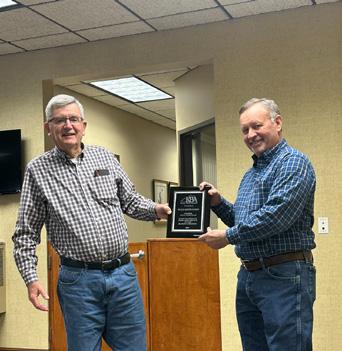



Kentucky team and the communities we serve,” stated Allen.
The Murray Bank President and CEO, Tony Ryan, presented Casey Brown with the Employee of the Quarter award at the Bank’s recent employee meeting. Casey currently works as Teller at the North Office. The Employee of the Quarter is given to individuals who consistently exemplify excellence in their roles, go above and beyond in their work, and serve as an inspiration to their colleagues. Congragulations to Casey for this award!
Republic Bank & Trust Company is proud to introduce two new members to the corporate leadership team. Promoted from within, Christy Ames now serves as Executive Vice President (EVP), Chief Legal Officer & General Counsel, and Scott Nardi takes on the role of Senior Vice President (SVP), Chief Risk & Compliance Officer.
FNB Bank is proud to announce that they have donated over $21,500 back to Mayfield, Graves County, Trigg County, and Marshall County Schools through their Spirit Debit Card Program. These donations to the school systems are a result of FNB’s 2nd quarter 2025 Spirit Debit Card Program.
Last but certainly not least, we’d like to give recognition to 12 Kentucky banking professionals from its nationally recognized leadership development
program. These individuals have completed GSBC’s rigorous 25-month curriculum, designed to prepare rising community bank leaders to make bold, strategic decisions that serve their institutions and communities: Robert Eddleman III, Citizens Deposit Bank, Cunningham, Daniel Friedman, Kentucky Department of Financial Institutions, Lexington, Jeremy Gray, First State Bank of the Southeast, Lexington, Dustin Hayes, Magnolia Bank, Leitchfield, Matthew Hurt, Citizens Bank of Cumberland County, Burkesville, Justin Marks, Independence Bank of Kentucky, Owensboro, Laken Masters, Peoples Bank of Ky, Inc., Flemingsburg, Charles Pride, Independence Bank of Kentucky, Owensboro, Brian Scott, Citizens Bank

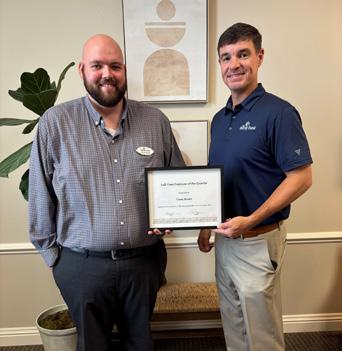


of Cumberland County, Burkesville, Rhonda Spalding, Town & Country Bank and Trust Co., Bardstown, Vic Swindler, FNB Bank, Mayfield, Scott Touro, and German American Bank, Louisville.These graduates were among 175 students honored during a ceremony held July 24 on the University of Colorado Boulder campus. GSBC’s Annual School Session, hosted each July, immerses rising community bank leaders in three consecutive years of classroom learning paired with six real-world intersession projects. Each student’s final project centers on a strategic opportunity or challenge unique to their organization, bringing immediate value back to their communities.





